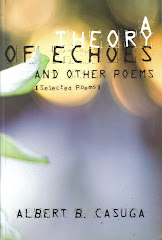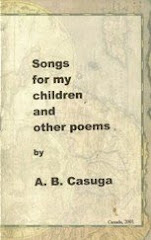19 March 2009
Cassar on Guido Monte
On 11 July 2008, Antoine Cassar posted this comment on the blog of Orlando de Rudder, who had talked about the multilingual writer Guido Monte: "Merci mille fois de cet extrait sur Guido Monte. Je vois qu'il travaille sur un projet similaire à le mien. J'aimerais savoir si ses poèmes sont essentiellement des centons ou bien s'il contiennent des vers écrits par lui-même." [Rough English translation: Thank you a thousand times for this post about Guido Monte. I see him working on a project similar to mine. I wonder if his poems are made up only of quotes from other writers or if they contain verses originally written by him.]
Monte writes "found poems" (poems consisting of or based on lines taken from previously existing texts, whether literary or not). The lines are in many languages. I understand that he is not even fluent in some of these languages.
Yes, the community of writers that write literary texts in more than one language is slowly but surely growing. There is hope!
Posted by Isagani R. Cruz at 4:12 AM
Albert B. Casuga said...
Poetry and linguistic blending posits as its main premiss the existence of certain "universal and cosmic vibrations" in lines of poetry that exists in a universe of thought -- an endlessly "percolating" vortex or matrix from which poets like Monte could "grasp" or "fish" for lines that he could blend together in order to "create" (compose is more like it)a separate poem that could stand on its own. While thought energies may suffuse currents upon currents of eddying "thought" atoms, it is a suspect idea to say that the lines of blended poetry come from the cosmos of eddying thoughts or thought patterns. Besides, most of the lines Monte would have used might already have seen print in books (from the Bible to myriad foreign text, extant or extinct) and the like and could, therefore, be "lifted" (or in today's legal circles "plagiarized") rather than "fished out" to become part of a creative expression in coalesced languages presenting itself as a "mosaic" of languages.
Is the main premiss of archetypal poetic energies or even lines valid? Monte assumes they do exist. Would his "cut and paste" poetry pass the litmus test of plagiarism? In fact, would it even approach the semblance of poetry?
If poetry is the objectification/ subjectification of an aesthetic experience in terms of verse media and linguistic devices (figures of language, of thought, and speech for instance), how would "borrowed, blended, embedded" poetry lines forming a "pastiche" of thoughts (at worst charivari) qualify as poetry?
What is poetic in poetry?
"Visual" and "concrete poetry" (not unlike Chinese and Japanese ideography) may be "blended" in the same manner as a "splish and splash" painter might. But is it poetry? Or is it a charlatan's sloth that dictates the quilt-like interlacing of poetry lines from all sources imaginable?
How will the following "blend" create a poem, indeed?
Adios, Patria Adorada, region del sol querida!
No duduaempay laeng ti peg-ges ni ayat,
Sa loob at labas ng bayan kong sawi,
My country 'tis of thee, sweet land of liberty, of thee I sing!
Perla del mar de Oriente'
Nuestro perdido Eden!
Nalawag nga unayen ti ulpit mo ken ranggas!
Beautiful land of love, O land of light,
In thine embrace, 'tis rapture to die!
Ang mamatay ng dahil sa iyo!
(A blend of extant lyric from Jose Rizal's "Mi Ultimo Adios", an Ilocano zarzuela love song "No Duduaempay", a line from the American national anthem "Star Spangled Banner" a line from 1800 Tagalog poet Francisco Balagtas's "Florante at Laura", that culminates with the last lines of the Philippine National anthem written in English and Tagalog.)
"Blended" Translation (mine):
Farewell, beloved country, beloved land of the sun,
(Spanish, Rizal)
If you still doubt my love's fervour for you, (Ilocano)
Inside and outside of this hapless country --
(Tagalog)
My country, O sweet land of liberty, of thee I sing!
(American anthem)
Pearl of the Orient seas, our lost Eden! --
(Rizal, Spanish)
If you still doubt my love for thee,
your cruelty and anger are to me clear!
(Ilocano)
Beautiful land of love, O land of light,
In thine embrace 'tis rapture to die!
(Filipino anthem)
I will gladly die for you!
(Filipino anthem's last line)
Did the "blend" ring true to the artistic purpose of lyrics that sing of one's undying love of one's country?
Will this exercise enhance the now impoverished lay of the poetic land? Or have the charlatans taken over, so theses could be written about "literary experiments" in grant-hungry Humanities Departments? --ALBERT B. CASUGA
19 March, 2009 11:00
4/25/2024
-
Overcast and cold, with a red-bellied woodpecker’s ceaseless whinnying. The
old crabapple tree is red and ready to open for sunshine and bees.
2 hours ago











No comments:
Post a Comment